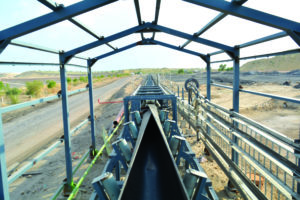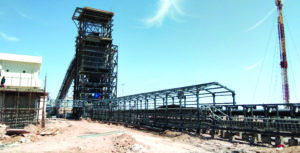
Barmer selects FLSmidth to supply a 6-million-mtpy crushing and conveying system near Jalipa in Rajasthan, India.
The Barmer Lignite Mining Co. Ltd. was established with a single mission: to supply lignite at -100 mm to the power plants of JSW Energy (Barmer) Ltd. Since 2011, Barmer has operated the Kapurdi open-cast lignite mine, 4 km to the north of the power plant. A second mine at Jalipa, located 2 km from the plant, is now being developed to augment the supply of lignite. This included construction of a crushing and conveying system to size and transport lignite to the power plant. A conveyor system was the preferred option to limit operating costs and reduce environmental impacts.
FLSmidth had previously constructed the conveyor system for the Kapurdi mine on an engineering, procurement and construction (EPC) basis. After a competitive bidding process, Barmer again awarded FLSmidth the contract to provide the solution for Jalipa. The EPC contract was awarded in November 2018 for a 6-million-metric-ton-per-year (mtpy) system. The scope of supply included:
Two Abon sizers;
Two apron feeders;
A 2.2-km pipe conveyor with a single 104° horizontal curve;
Three belt conveyors; and
An ECS/ControlCenter process control system.
“We chose FLSmidth based on their proven track record in material sizing and handling systems, including at our Kapurdi mine. Their ability to provide all the critical equipment in-house assured us of the quality of products being delivered, while their long-term service solutions guarantee trouble-free operation and supply of spare parts. We had no doubt that they would successfully execute this project,” Barmer Vice President of Operations Amrendra Kumar said.

The project included three conveyor systems and a 2.2-km pipe conveyor with a 104° horizontal curve.
Flexible Solution for Lignite Sizing and Transport
FLSmidth designed a flexible crushing system with two semimobile crushing stations employing an Abon sizer and apron feeder and feeding into the pipe conveyor. The relocatable crushing stations ensure that truck haulage from the operating face is kept to a minimum.
From the Jalipa mine, the pipe conveyor runs along the ground for 1.6 km, including two 35° curves, supported by sleepers and standard modular frames. For the remaining 0.5 km, the pipe conveyor is supported by galleries and trestles along a horizontal plan curve of 104°. Through this elevated curved section, gantries were supplied at a standard length and constructed using hollow square sections.
A further challenge came when routing the pipe conveyor near the power plant site. With existing structures to work around, as well as overburden soil dumps and private land, installation of the new tower for the pipe conveyor was far from a simple exercise.

FLSmidth constructs a lignite processing facility (above) that incorporates two Abon sizers, which will reduce the amount of fines created.
Expert Execution Brings Tangible Benefits
Installation of the new system on an EPC basis — which weighed in at about 1,000 mt — was carried out on site over a period of six months. Commissioning and performance guarantee testing are scheduled for mid-2020. In addition to the handling system, we also installed the ECS/ControlCenter V8 process control system — ensuring the mine is digital ready.
“Building on the success of the Kapurdi conveyor installation, we again proved ourselves to BLMCL as an expert one-source supplier for their Jalipa material handling needs. Although the project team encountered extreme weather conditions, the unseasonably heavy rains did not deter us from delivering the project,” FLSmidth Project Manager Kamlesh Mishra said.
By eliminating the need to transport lignite via truck, Barmer has lowered both its operating costs and environmental footprint. Truck maintenance and diesel costs are eliminated, for example, while the conveyor can operate in all conditions. Even in extreme weather that would keep trucks parked up. Limiting the number of trucks on-site also reduces the risk of accidents, improving safety conditions.
On the environmental side, CO2, SOx and NOx emissions are reduced, while there are zero emissions of dust from the pipe con-
veyor. Finally, the production of fines is also reduced by the use of sizers to crush and size the lignite. This has the dual benefit of again limiting dust emissions and ensuring a greater proportion of the lignite mined reaches the plant as usable fuel.




